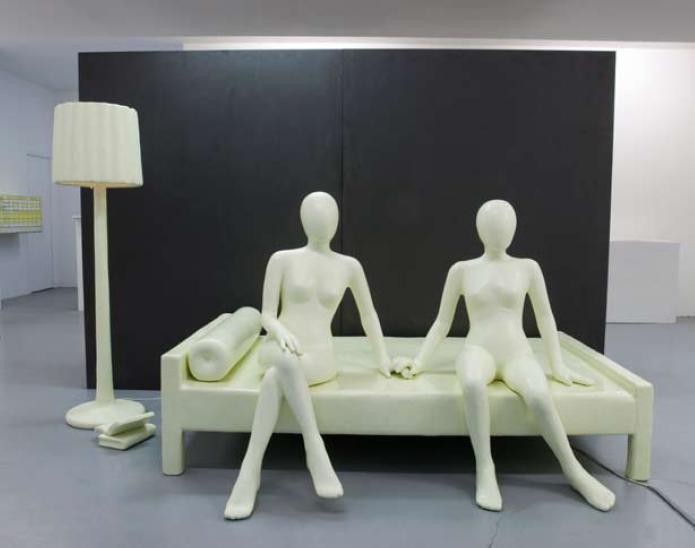Atelier van Lieshout
24 May - 26 Jul 2008
ATELIER VAN LIESHOUT
"Slave City"
Jousse Entreprise Gallery is delighted to invite you to the opening of AVL and Joep Van Lieshout on saturday 24 of may, from 4pm to 9pm, 24 and 34 rue Louise Weiss, PAris 13. The press release and visuals of the exhibition are available on request at the gallery. Press conference on friday 23 may in Sorbonne, Amphithéâtre Turgot at 17pm, 1 rue Victor Cousin or 17 rue de la Sorbonne, 75005 Paris. (organised by Art&Flux, Université Paris 1, Panthéon Sorbonne.) RSVP.
Slave City can be described as a sinister utopian project which is very rational, efficient and profitable (7,8 billion euro net profit per year).
Values, ethics, esthetics, moral, food, energy, economics, organization, management and market are turned upside-down, mixed and reformulated and designed into a town of 200.000 inhabitants.
Slave City is an up-to-date concentration camp made with the latest technology, and management insights. The inhabitants (which are called participants) work 7 hours a day on tele-services such as customers service, ITC, telemarketing, computer programming etc. etc. After that, they work 7 hours on the fields or workshop in order to keep slave city and its participants working. The efficiency of the participants is monitored accurately and appropriate measures are taken if it drops under a set level.
Slave City is the first ‘zero energy’ town of this size in the world and functions without imported mineral fuel or electricity. The energy needs of the Slave City are covered by using biogas, solar and wind energy and bio-diesel. Everything is majestically recycled, even the participants. No waste products are produced and the slave city is a green town which is not wasting the worlds resources.
Except the many necessary infrastructure and service buildings there is also sumptuous head office, safe and cozy village for the higher employees, education, health centre, brothel and art centre.
SlaveCity is worked out in drawings (Ink on Canvas) and architectural models (wooden brothels, minimal steel models, white plastic). Both show the life and work of the slaves inside the city as well as the buildings like the energy plant, hospital, university, museum, brothels and so on.
"Slave City"
Jousse Entreprise Gallery is delighted to invite you to the opening of AVL and Joep Van Lieshout on saturday 24 of may, from 4pm to 9pm, 24 and 34 rue Louise Weiss, PAris 13. The press release and visuals of the exhibition are available on request at the gallery. Press conference on friday 23 may in Sorbonne, Amphithéâtre Turgot at 17pm, 1 rue Victor Cousin or 17 rue de la Sorbonne, 75005 Paris. (organised by Art&Flux, Université Paris 1, Panthéon Sorbonne.) RSVP.
Slave City can be described as a sinister utopian project which is very rational, efficient and profitable (7,8 billion euro net profit per year).
Values, ethics, esthetics, moral, food, energy, economics, organization, management and market are turned upside-down, mixed and reformulated and designed into a town of 200.000 inhabitants.
Slave City is an up-to-date concentration camp made with the latest technology, and management insights. The inhabitants (which are called participants) work 7 hours a day on tele-services such as customers service, ITC, telemarketing, computer programming etc. etc. After that, they work 7 hours on the fields or workshop in order to keep slave city and its participants working. The efficiency of the participants is monitored accurately and appropriate measures are taken if it drops under a set level.
Slave City is the first ‘zero energy’ town of this size in the world and functions without imported mineral fuel or electricity. The energy needs of the Slave City are covered by using biogas, solar and wind energy and bio-diesel. Everything is majestically recycled, even the participants. No waste products are produced and the slave city is a green town which is not wasting the worlds resources.
Except the many necessary infrastructure and service buildings there is also sumptuous head office, safe and cozy village for the higher employees, education, health centre, brothel and art centre.
SlaveCity is worked out in drawings (Ink on Canvas) and architectural models (wooden brothels, minimal steel models, white plastic). Both show the life and work of the slaves inside the city as well as the buildings like the energy plant, hospital, university, museum, brothels and so on.

